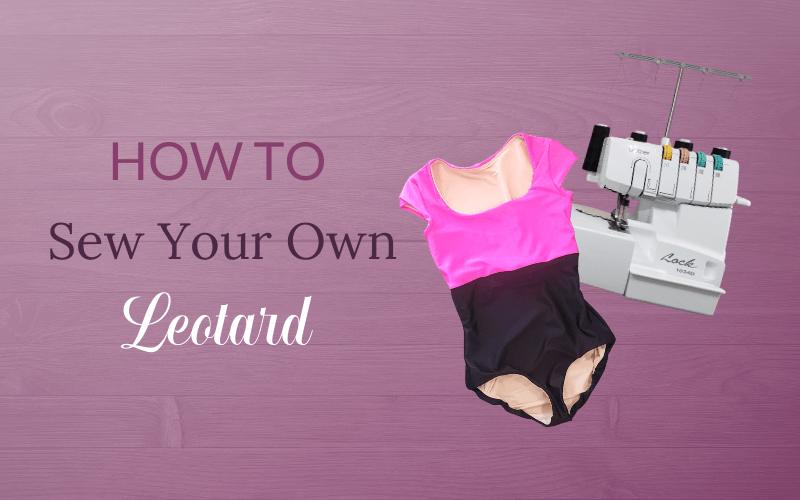I’ve talked before about why you should make your own leotards. My last blog post was about how to start, by making a customized basic leotard pattern that you can use over and over to design new leotards. Today I’m going to tell you more about how to actually sew a custom-fit, comfy leotard together!
Separate the top, bottom, and lining pattern pieces
The first thing I like to do is separate all my pattern pieces into piles according to which fabric I will use. For the leotard I make in the DIY Athletic Leotard Course, the top is pink, the bottom is black, and then there’s the lining.
Divide the pattern pieces into piles so that you won’t absentmindedly cut the wrong piece out of the wrong fabric. I’m especially likely to make this mistake with the outside pieces and the lining, since they’re so close—they’re almost exactly the same shape, but slightly different sizes. Taking this extra step helps us avoid human mistakes that will cause us grief later.
Cut out the fabric
After we’ve got our piles, we take one at a time and cut out the pieces with the right fabric. It’s important to be consistent—decide which side of the fabric is the right side/outside and stick to it, and decide which side is the top and which is the bottom and stick to it.
When I cut out pattern pieces, I tend to start with the biggest and go to the smallest so that I can use my fabric as efficiently as possible. I suggest you do the same to avoid having an oddly shaped, too-small piece of fabric to try to fit your larger pattern pieces into.
Lay out the pattern pieces, right sides together
Once all the pieces in all the fabrics are cut out, lay them out right sides together, the way they will be sewn together. Especially if there’s not an obvious right and wrong side of the fabric, doing this now helps again with not making human mistakes later.
Thread the machines
Next, thread your machines—my coverstitch machine pretty much always has thread that matches my lining, since the stitching is only seen on the inside. We thread the serger with thread that matches the outside fabrics.
Of course, a regular sewing machine with a zigzag stitch can also be used to sew the leotard. I prefer a serger and coverstitch machine for many reasons, but if you only have a regular sewing machine or feel intimidated by the heavier duty sewing machines, don’t let this hold you back!
One of the things that intimidates people about these machines is threading them. It is a bit more complicated, with 3 or 4 spools instead of just 1 spool and a bobbin, but it’s really not difficult to learn and the perks of sewing with these machines are definitely worth it, if you ask me.
Sew the shoulders and neckline
Now we finally start sewing! We sew across the shoulders, on the outside fabric pieces and the lining. Then we put the two right sides together.
Next we sew around the neckline. The neckline can use some extra security, so this is one of the places we put elastic. The elastic is a bit shorter than the circumference of the neckline so that it will be snug.
We pin the elastic to the neckline and then serge it on!
Where we sew on elastic, we also do what I call coverstitch understitching, haha. We understitch (sew the seam allowance to the lining) with a coverstitch machine to help pull the lining to the inside and give the neckline a smooth, crisp edge.
Sew the sleeves and side seams
Next we pin on and sew the 4 sleeves—the 2 outside and the 2 lining sleeves. I use a pin to match up the center of the sleeve cap to the shoulder seam, and then I stretch and manipulate the fabric to make the sleeve match the armhole, and sew. Of course you can use more pins if you’re more comfortable with that.
Now it’s time for some burrito-style sewing, haha. We wrap the inside and outside pieces of a sleeve around the rest of the top of the leotard to meet each other, right sides together, and sew them. Then we turn them inside-out and find a lovely sleeve with enclosed seams! It’s disorienting but magical. 😉 We repeat for the other sleeve.
Then we flip the leotard around in another way that feels inside-out and backwards in order to sew one side seam of the top together, and then the other.
To finish the top, we sew the outside and the lining together around the bottom.
Sew the crotch and the legholes
Now we do almost the same thing as we did on the top, but upside-down. We start by sewing the crotch pieces together on both the outside and the lining pieces. Then we put the lining and the outside pieces right sides together.
Next we sew the legholes of the lining and the outside together. If you’ve ever sewn a leotard before, you know this seems out of order. Usually you sew the legholes last, but we change the order to give the leotard comfy, silky, enclosed seams.
Like we did on the neckline, we measure elastic, pin it to each leghole, and sew it on. We make the elastic even shorter this time, because the legholes need quite a bit more security than the neckline does. We barely stretch the elastic at all on the front of the legholes, but we stretch it out a lot more in the back.
Once again, we coverstitch understitch the elastic to the lining. It’s a bit more involved this time, because we have to sew through the rather skinny crotch tunnel. This means that we sew as far as we can from one direction, then we pull it out of the machine and come in from the other side to finish. We do this on both legholes.
Finally, we reach through the crotch tunnel and pull the fabric right side out. The hardest part is over!
Sew the side seams
We match up the elastic on the legholes, and we sew the side seams of the bottom. We do this on both sides, and then we sew the lining and the outside layers together on the top.
Sew the top and the bottom together
Now we have a full top piece and a full bottom piece! We fold the top piece inside-out over the bottom, and we sew the two serged edges together—and we’re done!!!
Once again, I’ve provided a visual—another video time-lapse. Click here to see the first time-lapse I made, which covers how to make a customized basic leotard pattern for you to use to design new leotards!
If you haven’t yet, you can sign up here for my free DIY Athletic Leotard Course. You’ll see everything in this video much slower, broken down with step-by-step instructions. Hope to see you inside the course! 😄


